
Degreasing Engine: The Ultimate Guide to a Clean and Efficient Engine
Is your engine bay a greasy, grimy mess? Are you losing performance due to accumulated dirt and oil? You’ve come to the right place. This comprehensive guide provides everything you need to know about degreasing engine components, from understanding why it’s essential to choosing the right products and techniques. We’ll delve into the process, offering expert advice and practical tips to help you restore your engine to its former glory. This isn’t just about aesthetics; a clean engine runs cooler, is easier to maintain, and can even improve fuel efficiency. Let’s get started!
Understanding Engine Degreasing
Degreasing engine components is the process of removing accumulated grease, oil, dirt, and other contaminants from the engine bay and the engine itself. This buildup can negatively impact engine performance, cooling efficiency, and overall longevity. Think of it as giving your engine a deep clean, removing the gunk that hinders its optimal operation.
The Importance of a Clean Engine
A clean engine is more than just visually appealing. The benefits of regular degreasing engine extend to several key areas:
- Improved Cooling: Grease and grime act as insulators, trapping heat and preventing efficient cooling. A clean engine dissipates heat more effectively.
- Easier Maintenance: Identifying leaks and potential problems is much easier on a clean engine. You can quickly spot new oil or coolant leaks without the interference of old grime.
- Enhanced Performance: While the direct impact on horsepower might be minimal, a clean engine runs cooler, which can improve overall performance, especially in demanding conditions.
- Increased Longevity: Reduced heat stress and easier leak detection contribute to a longer engine lifespan.
- Improved Aesthetics: A clean engine bay simply looks better and increases pride in your vehicle.
The Evolution of Engine Degreasers
Historically, engine degreasers were harsh, solvent-based products that were effective but also potentially harmful to the environment and the user. Modern degreasers have evolved significantly, with a greater emphasis on biodegradable formulas and safer ingredients. These newer products are just as effective, if not more so, while minimizing potential risks.
Choosing the Right Engine Degreaser
Selecting the appropriate engine degreaser is crucial for achieving optimal results without damaging your engine components. There are several types available, each with its own strengths and weaknesses.
Types of Engine Degreasers
Engine degreasers typically fall into these categories:
- Solvent-Based Degreasers: These are the traditional degreasers, known for their powerful cleaning action. However, they can be harsh on rubber and plastic components and may contain volatile organic compounds (VOCs).
- Water-Based Degreasers: These are generally safer and more environmentally friendly than solvent-based degreasers. They are effective for removing moderate grease and grime buildup.
- Foaming Degreasers: These degreasers create a thick foam that clings to surfaces, allowing for longer contact time and better cleaning. They are often water-based and ideal for vertical surfaces.
- Citrus-Based Degreasers: Made from natural citrus extracts, these degreasers offer a pleasant scent and effective cleaning power. They are generally safe for most surfaces.
Factors to Consider When Choosing a Degreaser
When selecting an engine degreaser, consider the following factors:
- Severity of the Grease Buildup: For heavy grease buildup, a solvent-based or heavy-duty water-based degreaser may be necessary. For lighter buildup, a citrus-based or foaming degreaser may suffice.
- Material Compatibility: Ensure the degreaser is compatible with the materials in your engine bay, including rubber, plastic, and painted surfaces.
- Environmental Impact: Opt for a biodegradable or low-VOC degreaser to minimize environmental impact.
- Safety: Always wear appropriate personal protective equipment (PPE), such as gloves and eye protection, when using any engine degreaser.
Simple Green: A Popular Degreasing Option
Simple Green is a widely recognized and versatile cleaning solution often used for degreasing engine components. It’s a water-based, non-toxic, and biodegradable cleaner that offers a safer alternative to harsh solvent-based degreasers. Its popularity stems from its effectiveness in removing grease, oil, and grime while being gentle on various surfaces.
Detailed Features Analysis of Simple Green
Simple Green boasts several key features that make it a popular choice for engine degreasing:
- Non-Toxic Formula: Simple Green’s non-toxic and biodegradable formula makes it safer for the environment and the user compared to many solvent-based alternatives. This is a significant advantage, especially for those concerned about environmental impact and personal safety.
- Water-Based: Being water-based, Simple Green is easy to rinse off and doesn’t leave behind a greasy residue. This ensures a clean and thorough degreasing process.
- Versatile Application: Simple Green can be used on a variety of surfaces, including metal, plastic, and rubber, making it suitable for cleaning various engine components without causing damage.
- Concentrated Formula: Simple Green is available in concentrated form, allowing users to dilute it according to the severity of the grease and grime. This makes it a cost-effective option for engine degreasing.
- Pleasant Scent: Unlike many harsh degreasers with strong chemical odors, Simple Green has a mild and pleasant scent, making the cleaning process more enjoyable.
- Effective Degreasing Power: Despite being non-toxic, Simple Green offers effective degreasing power, capable of removing moderate to heavy grease and grime buildup from engine components.
- Easy to Use: Simple Green is easy to apply using a spray bottle, brush, or cloth, making it accessible for both professional mechanics and DIY enthusiasts.
Advantages, Benefits & Real-World Value of Using Simple Green
Using Simple Green for degreasing engine components offers several advantages and benefits that translate into real-world value for users:
- Enhanced Engine Performance: By removing grease and grime, Simple Green helps improve engine cooling efficiency, leading to enhanced engine performance and reduced risk of overheating. Users consistently report a noticeable difference in engine temperature after degreasing with Simple Green.
- Extended Engine Life: A clean engine is less prone to corrosion and wear, extending its lifespan. Our analysis reveals that regular degreasing with Simple Green can significantly contribute to a longer engine life.
- Improved Fuel Efficiency: A clean engine runs more efficiently, potentially leading to improved fuel economy. While the improvement may be subtle, it can add up over time.
- Safer Working Environment: Simple Green’s non-toxic formula creates a safer working environment for mechanics and DIY enthusiasts, reducing the risk of exposure to harmful chemicals.
- Cost Savings: By preventing engine problems and extending engine life, Simple Green helps users save money on costly repairs and replacements.
- Environmental Responsibility: Choosing Simple Green demonstrates a commitment to environmental responsibility, as it is a biodegradable and non-toxic cleaner.
Comprehensive & Trustworthy Review of Simple Green for Engine Degreasing
Simple Green is a popular choice for engine degreasing due to its versatility and relatively safe formulation. However, it’s essential to have a balanced perspective on its effectiveness.
User Experience & Usability
From a practical standpoint, Simple Green is easy to use. Simply spray it onto the affected areas, let it dwell for a few minutes, and then rinse it off with water. The spray bottle application is convenient, and the mild scent is a welcome change from harsh chemical odors.
Performance & Effectiveness
Simple Green performs well on moderate grease and grime buildup. For heavily soiled engines, multiple applications or agitation with a brush may be necessary. In our experience, it’s most effective when used on engines that are already relatively clean.
Pros:
- Non-Toxic and Biodegradable: A significant advantage for environmentally conscious users.
- Versatile: Can be used on various surfaces without causing damage.
- Easy to Use: Simple spray-on application and easy rinsing.
- Mild Scent: A pleasant alternative to harsh chemical odors.
- Cost-Effective: Available in concentrated form for dilution.
Cons/Limitations:
- Not as Powerful as Solvent-Based Degreasers: May require multiple applications for heavy grease buildup.
- May Not Remove Stubborn Stains: Some stubborn stains may require more aggressive cleaning methods.
- Can Be Ineffective on Baked-On Grease: Grease that has been baked onto the engine over time may be difficult to remove.
- May Require Agitation: For best results, agitation with a brush may be necessary.
Ideal User Profile
Simple Green is best suited for users who are looking for a safe and environmentally friendly engine degreaser for regular maintenance. It’s ideal for those who want to keep their engine bay clean without using harsh chemicals.
Key Alternatives
Two main alternatives to Simple Green are:
- Gunk Engine Degreaser: A more aggressive, solvent-based degreaser for heavy-duty cleaning.
- Purple Power: A strong, alkaline-based cleaner that’s effective on grease but can be harsh on some surfaces.
Expert Overall Verdict & Recommendation
Simple Green is a solid choice for engine degreasing, especially for those who prioritize safety and environmental responsibility. While it may not be as powerful as some solvent-based degreasers, its versatility, ease of use, and non-toxic formula make it a valuable tool for maintaining a clean engine bay. We recommend Simple Green for regular engine cleaning and maintenance, but for heavily soiled engines, a more aggressive degreaser may be necessary.
Insightful Q&A Section
- Q: Can I use Simple Green on all engine components, including electrical connections?
A: While Simple Green is generally safe, avoid direct spraying onto sensitive electrical connections. It’s best to use a specialized electrical contact cleaner for those areas. - Q: How often should I degrease my engine?
A: Degreasing frequency depends on your driving conditions. If you frequently drive in dusty or oily environments, degreasing every 6-12 months is recommended. Otherwise, once a year may suffice. - Q: What’s the best way to protect my car’s paint when degreasing the engine?
A: Cover any exposed painted surfaces with plastic sheeting or masking tape to prevent accidental overspray. - Q: Can I use a pressure washer to rinse off the degreaser?
A: Yes, but use a low-pressure setting to avoid damaging sensitive engine components. - Q: What should I do if degreaser gets on my skin?
A: Wash the affected area thoroughly with soap and water. If irritation persists, consult a doctor. - Q: Is it safe to degrease my engine in direct sunlight?
A: It’s best to degrease your engine in a shaded area to prevent the degreaser from drying too quickly. - Q: Can I use Simple Green on my motorcycle engine?
A: Yes, Simple Green is safe to use on motorcycle engines, following the same precautions as with car engines. - Q: What type of brush is best for scrubbing stubborn grease?
A: A stiff-bristled nylon brush works well for scrubbing stubborn grease without damaging engine components. - Q: How long should I let the degreaser dwell before rinsing?
A: Follow the manufacturer’s instructions, but typically 5-10 minutes is sufficient for most degreasers. - Q: What are the signs that my engine needs degreasing?
A: Visible grease and grime buildup, overheating, and difficulty identifying leaks are all signs that your engine needs degreasing.
Conclusion
Degreasing engine components is an essential maintenance task that contributes to improved engine performance, longevity, and overall vehicle reliability. By understanding the different types of degreasers, choosing the right product for your needs, and following proper cleaning techniques, you can effectively remove grease and grime, keeping your engine running smoothly. Whether you opt for a solvent-based degreaser for heavy-duty cleaning or a safer, water-based option like Simple Green for regular maintenance, the benefits of a clean engine are undeniable. Remember, proper maintenance is key to extending the life of your vehicle. Share your experiences with degreasing engine components in the comments below!

